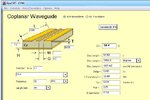Simo.Da
Junior Member level 2
Hello guys
I am really seeking some and some guidance regarding the coplaner waveguide.
I am trying to make a PCB design for class A RF PA.
I have done almost the design but I'm struggling in coplaner waveguide input matching (Zin=6.4-j65 at the base). I did the match using ADS, but I don't know how to make the PCB design using circuit maker.
Please find attached what I have done so far, and correct me if anything looks wrong please.
Thanks




I am really seeking some and some guidance regarding the coplaner waveguide.
I am trying to make a PCB design for class A RF PA.
I have done almost the design but I'm struggling in coplaner waveguide input matching (Zin=6.4-j65 at the base). I did the match using ADS, but I don't know how to make the PCB design using circuit maker.
Please find attached what I have done so far, and correct me if anything looks wrong please.
Thanks






